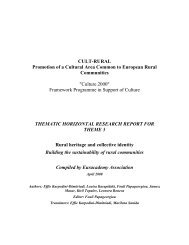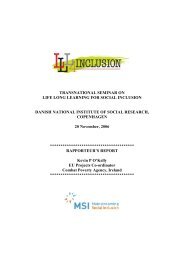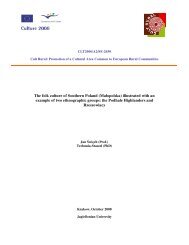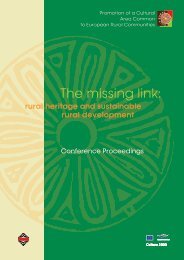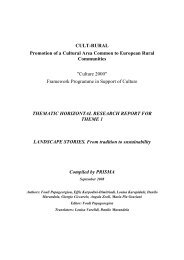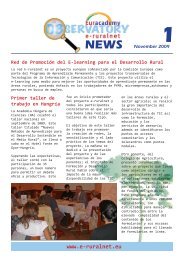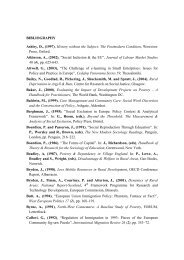ÐÐ¾Ð´Ð°Ñ Ð¿Ð¾ изложбаÑа - cult rural - Prisma
ÐÐ¾Ð´Ð°Ñ Ð¿Ð¾ изложбаÑа - cult rural - Prisma
ÐÐ¾Ð´Ð°Ñ Ð¿Ð¾ изложбаÑа - cult rural - Prisma
You also want an ePaper? Increase the reach of your titles
YUMPU automatically turns print PDFs into web optimized ePapers that Google loves.
APOTROPAIC AND PROTECTIVE RITES<br />
processions was the continuation of Christmas caroling. On one hand they had<br />
religious character, since they reminded the inhabitants of towns and villages of<br />
the evangelic events related to the birth of the Messiah. On the other hand, they<br />
had magic functions: to provide the soil and animals with fertility and people with<br />
good luck in the forthcoming year. If the carol singers and people in fancy dress<br />
missed a house, it was a bad omen. Only men went caroling, mainly bachelors<br />
and lads, comprising a colourful and humorous travel folk theatre. The popular<br />
element of carol singing groups was a star – moveable, polygonal, carried on<br />
a long pole, lit from the inside, as a reference to the Star of Bethlehem and a<br />
symbol of good luck. They also carried a crib, a small richly decorated building<br />
with mobile or static fi gures inside related to the scene of Christ’s birth with<br />
“Herod” and animal monsters: a goat, a bear, a stork, a horse and a “turoń” – an<br />
ancient magic animal.<br />
The tradition of a mobile crib was derived from nativity plays that were initially<br />
held in churches. At the end of the 18th century the cribs, as a caroling rite, went<br />
out of churches performing scenes related to Christ’s birth.. Small, moveable<br />
cribs with portable statuettes were constructed by domestic artists; they took<br />
the form of a stable with two towers on the sides. A typical Polish specialty was<br />
widening the gallery of characters accompanying the main plot of the birth of<br />
Christ by including statuettes of peasants, merchants, inn owners, soldiers and<br />
other people with whom the viewers are familiar from every day life.<br />
The richest setting among the cribs was given to the so-called “Cracow crib”,<br />
considered to be one of the phenomena of Polish folklore. It dates back to the<br />
middle of the 19th century, when the carpenters, brick-layers and tillers from<br />
the suburbs and neighbouring villages, deprived of jobs during winters started<br />
making small cribs for presents and bigger ones for the groups of carolers. In<br />
the beginning of the 20th century, under the influence of mason master Michał<br />
Ezenekier, a characteristic form evolved related to the architecture of Cracow’s<br />
buildings.<br />
Caroling with “Herod” is a peculiar show referring to the evangelic record<br />
about the birth of Christ, the Homage of the Three Wise Men, the Massacre<br />
of the Innocents and the death of King Herod. An important role is played by<br />
people dressed up like animals and supernatural, weird creatures. They are<br />
very animated. They run all over the room, snap their moveable mouths gore<br />
with their horns, and at a certain time they perform an enactment of death and<br />
resurrection. These monsters symbolize fertility and the revival of nature, and<br />
their presence at home is intended to provide good luck. Herod’s death, which<br />
completes the play, represents the death of nature and its rebirth in the spring; it<br />
also symbolizes the birth of a new King – Jesus. All the participating characters<br />
must have appropriate outfits (fur coats, old uniforms, cardboard armour, helmets<br />
and wooden sabres), and, most importantly, fanciful masks covering their faces.<br />
Fancy dress, set gestures and behaviour are meant to reflect the character of<br />
specific people and scenes. The devil is very active, besides a mask with horns<br />
and tongue, a tail and chain; it has a fork, with which he threatens the residents,<br />
particularly the children. The show lasts from a few to over ten minutes and<br />
finishes by collecting contributions for the carolers.<br />
23. „Draby”, phot. W. Dragan, R. Styga, 2000, Poland<br />
(Museum of Folk Culture in Kolbuszowa)<br />
24 New Year’s „Draby” from Nawsie near Wielopole,<br />
Ropczyce, Podkarpackie voivodship, phot. 1990’s.,<br />
Poland (Etnographic Museum in Rzeszów)<br />
25. Cracow’s Crib, made by: Bronisław Pięcik, 1989,<br />
Poland (Etnographic Museum in Cracow)<br />
14<br />
23.<br />
24.<br />
26. Masks of „Herod’s” groupe, made by: M.<br />
Strzębicki, Ruda Różaniecka, Podkarpackie<br />
voivodship, 1997, Poland (Museum Kresow in<br />
Lubaczów)




